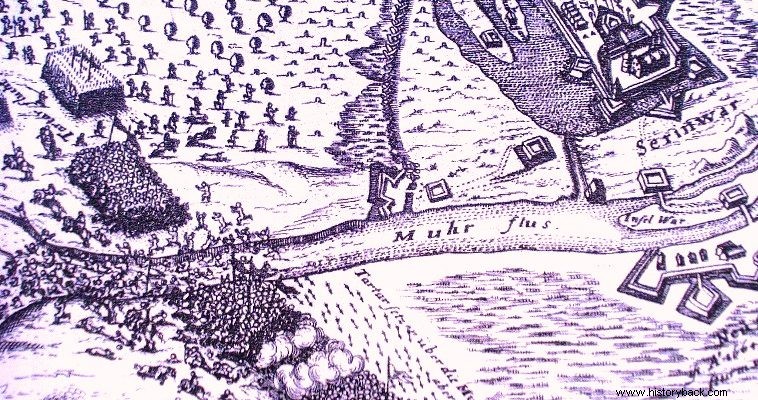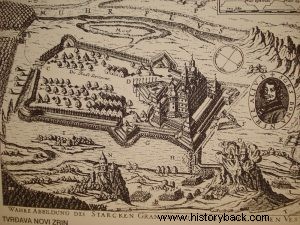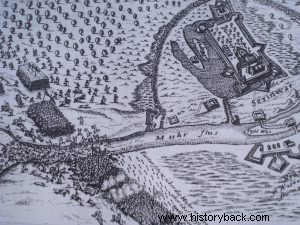
In 1663 the Turks once again invaded the lands of the Habsburg Empire with a large army of 100,000 men. The Austrians fearing a Turkish attack on Vienna concentrated their small available forces on the Raab River in Hungary, leaving other areas to their own devices. The siege was built at the confluence of the Drava River with the Mura tributary, on the current Croatian-Hungarian border.
About 1,900 men (1,200 Austrians and Germans and 700 Hungarians and Croats) were fortified in the small castle, under the Austrian Wolfgang Julius von Hohenlohe. Further north had been deployed the main force of the Habsburg Imperial army, with a strength of less than 30,000 men.
The small garrison also had 24 guns. All available food and supplies were gathered, with the would-be besiegers even rushing Turkish supply convoys. Opposite the Albanian grand vizier Ahmet "fazil" (wise) Kioprulu had a huge army of at least 100,000 men - 70,000 Turks and 30,000 Tatars. The good thing for the Christians was that the castle was covered by 3/4 of its perimeter walls by both rivers and the attack against it could only be carried out through a narrow passage.
Siege
In early June the huge Ottoman army appeared in front of the castle. On June 5 the grand vizier gave the order to begin the siege. The Turks built rafts and charged furiously against the few defenders, from almost all sides trying to saturate the defenses. But for three days they achieved nothing, except to fill the area with carcasses. On June 8, Ahmed ordered his heavy guns to open fire on the castle. The Turks built two artillery emplacements.
After an intensive bombardment, the Turks launched a new attack with fanaticism and momentum, but the Christians fought like lions, literally cutting them down. There followed another bombardment, another attack, another massacre of the Turks, another bombardment, another attack, another massacre. After this the Turks sent a messenger to the castle demanding its surrender, promising to allow the safe evacuation of the garrison.
Hohenlohe, however, rejected the request without discussion, and not only that, but ordered his adjutant Baron d'Avancourt to march out with 1,500 men. Indeed the Christian counter-attack took the Turks completely by surprise. Their siege trenches were destroyed, cannons were "buried", hundreds of Turks were mercilessly slaughtered. After this unpleasant surprise, the Turks took their measures and thus a new exodus of Christians was successfully dealt with.
Continuous attacks
Having failed to take the castle by storm, the Turks began to dig sewers with the aim of undermining and tearing down the walls. At the same time, a new artillery station was created where the heaviest Turkish cannons were placed which, from that moment until the end, did not stop firing against the Christians, supporting the one offensive wave of the Turkish infantry and dismounted infantry, one after the other.
While this was happening the Austrian commander-in-chief Marshal Montecucoli managed to get reinforcements into the castle – about 1,000 men. However, he could not do anything more and he made it clear to the defenders and gradually withdrew whatever forces he had in the area.
Sword and blood
From June 24, the Turks concentrated their attacks on the citadel of the fortress. In their first raid the Christians literally cut them down with their fire. After all, the Turks were so numerous that even if the defenders wanted to fail, it was simply not possible. The attack was repulsed, but others followed during the night and the following day.
After this, as thousands of Turkish corpses had filled the space below the ramparts, the Vizier Ahmed ordered a cessation of attacks. The Christians initially thought that the Turks were degenerate. But they learned on their own they were just preparing. Indeed the Turks built a large wooden bridge and filled the trench with earth. Nevertheless, the Christians were not disappointed and took advantage of the break to sort of repair the badly battered walls.
In the following days, the Turkish pressure intensified. D'Avencourt was seriously wounded. He was replaced by Colonel Tasso, but the defenders had reached the point of exhaustion. On June 30 the grand vizier ordered a general attack. Beyond all expectations, the defenders held out even though they suffered heavy losses. Faced with this situation, Montecucoli sent a message to the defenders ordering them, if they could hold out no longer, to blow up the fort and attempt to escape.
Evacuation and destruction
Fortunately for the besieged, from the 1st of July it began to rain in torrents. The rain was a godsend for the overworked defenders as it delayed the Turks. However, the defenders saw that there was no hope and thus finally abandoned the fort. Several were killed trying to cross a makeshift bridge and join Montecucoli's army.
A few remained in the fort and fell fighting to the end. The Turks, after their "victory", completely leveled the fort. The losses were terrible for the Turks. At least 10,000 of their men were lost in the siege, compared to about 2,000 Christians. The castle was never rebuilt. Today an obelisk stands in its place, a monument to the brave few who fought there against Asian barbarism.


